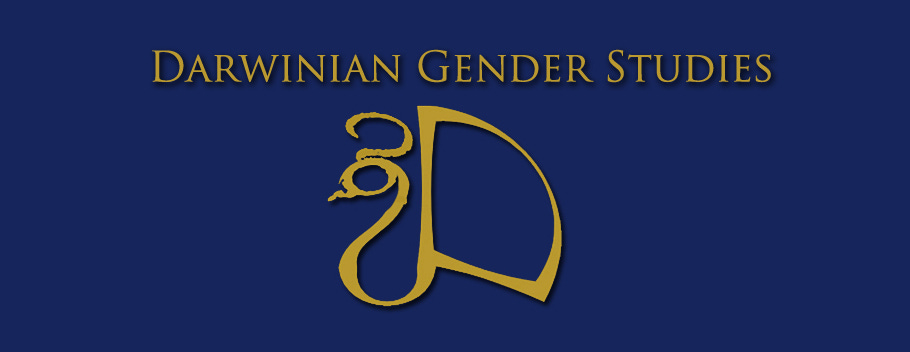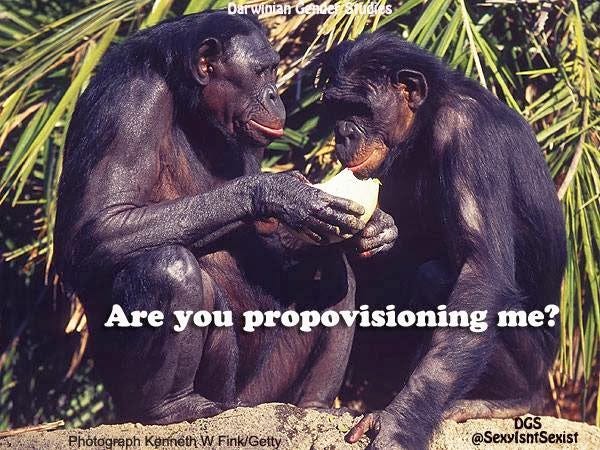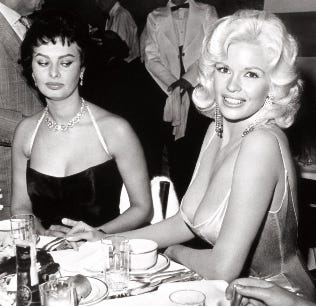Darwinian Gender Studies: Unpoisoning The Well
One sex cannot be understood except in light of the other. Men and women have co-evolved, each shaping the other both physically and psychologically via natural and sexual selection.
If any man could draw up a comprehensive, infallible guide to navigating this treacherous territory, we would certainly erect a statue to his everlasting memory. There is a Twitter account dedicated to exploring and enumerating precisely the distinctions and differences between the acceptably erotic and the intolerably sexist. It’s called @SexyIsntSexist. It is, of course, under the control of a woman.” Neil Lyndon. Do men really understand what sexism is? The Telegraph 20/5/14
I created Darwinian Gender Studies (DGS) in 2008 as a cross-disciplinary area of study and research which utilises insights across the evolutionary behavioural sciences, including but not limited to, evolutionary psychology, biology, anthropology, ethology, palaeoanthropology and cultural evolution. It represents the consilience of the natural and social sciences, as envisioned by E. O. Wilson.
Back then, my planned PhD thesis was to be in developing an evolutionary, bio-cultural model of ‘patriarchy’ which challenged the premises of the feminist conception of patriarchy. Even in 2008, the project foresaw that political correctness, social justice and toxic feminism were taking us deep down the postmodern rabbit hole. My goal was to build bridges of understanding between the sexes not walls of fear and mistrust, which is what feminism does today. To learn about humans and humanity; what we are, and what we are not.
Two things we are, which we cannot cease to be and remain human, are a sexually reproducing, moderately sexually dimorphic, pair-bonded species. These are basic facts of our human nature which cannot be erased by social engineering.
Within DGS, I interrogate orthodox feminist concepts, such as patriarchy theory, objectification theory, gender, power, mating strategies, and sex differences and similarities, using humour and evolutionary explanatory models such as natural and sexual selection, parental investment theory, female choice, signalling theory, life history theory, intersexual competition and intrasexual competition.
History has demonstrated many times, that whenever our species attempts to take control of biology and bend it out of shape to ideological goals, human tragedy always follows. It’s a lesson we still don’t seem to have learned, as in spite of overwhelming evidence, many people still hold fast to the idea of an endlessly flexible human nature, and indeed, human nature is flexible, but a blank slate it is not. Neither however is it a crude caricature of immutable deterministic drives and instincts as often painted within the straw man of biological determinism. Human nature is very much mutable, but not infinitely or arbitrarily so, and here lies the nub: Within what may seem like infinite variations of human action and reaction to what life throws at us, our predispositions on an average scale are actually predictable. There are enough constants within this calculus to recognise the existence of an unmistakably human nature. This nature will vary and recalibrate between individuals and ecologies (variation is one of the engines of evolution) but these variations dance around a constant, evolutionary fire.
“Those who journey from political correctness to truth often risk public disapprobation, but it is notable that most never lose their tolerance or humanity. They may question the politics of race, but not that racism is bad; they may question campaigns about women’s pay, but not that women and men deserve equality of treatment.” Browne, A. (2006) The Retreat of Reason: Political correctness and the corruption of political debate in modern Britain. Civitas
I was, and am, standing on the shoulders of many female evolutionary scientists and philosophers who came before me such as Barbara Smuts, Sarah Blaffer Hrdy, Anne Campbell, Helena Cronin, Griet Vandermassen, Catherine Salmon, Maryanne Fisher, Bobby Low, Helen Fisher, and many more. Over the last 50 years, their scholarship has revealed that, far from feminist fears to the contrary, evolved sex differences do not equate to inferiority. Via evolution, we in fact see true equality expressed in discrete and fascinating ways.
These women (and many men) have illuminated the role females play as potent agents of evolution via the phenomenon of female choice. This is sadly still an unsung revolution – unsung by feminism, not evolutionists – as it shattered the male perspective biases that once dominated biology and Darwinism. These women did this, not with rhetorical declarations of war against ‘patriarchy’ but with logic and critical thinking.
When it comes to the principles of natural selection – the struggle to survive – men and women differ very little. Rather, it is in the principles of sexual selection – the struggle not just to survive but thrive enough to have offspring and allow them to thrive also – that the main differences start to become manifest. It is a categorical fact that none of these differences equates to any moral inferiority. No genuine evolutionary scholar would ever make such a claim.
Feminists have long claimed that logic is an exclusively male trait. So much so that to counter the “male” scientific method they felt the need to create “female” method – social constructionism - which ironically invokes every negative female stereotype they claim to want to refute. They did this not because social constructivism was a better tool – it is untested – but because it was the binary opposite of the scientific method.
Women, in fact, have nothing to fear from logic. Yet feminists do fear it, as philosopher Janet Radciffe Richards notes in her book The Sceptical Feminist,
“…in spite of girls doing better at school than boys, feminists are still woeful at rationality…feminism has some tendency to get stuck in the quagmire of unreason from time to time [but] it cannot be denied that adopting an anti-rational stance has its uses; it can be turned into an all-purpose escape route from tricky corners”
They also fear it because it falsifies the very premises feminism rests on – especially female inferiority.
This is a description of all feminisms today: radical, intersectional and all other tribes battling for dominance in the victim narrative – including ideological men’s rights, MGTOW and “red pill” groups. All feminisms eschew logic and reason for dogma and ideology and all are in thrall to the flying patriarchal spaghetti monster in the sky. Ask a question about female oppression, you already know the answer: it’s the patriarchy, stupid. And ideological men’s groups have their own version of patriarchy, known as gynocentrism. Both concepts are intellectually myopic.
I created DGS all those years ago because I wanted the opportunity to have a role, however small, in helping us better understand ourselves as a species.
It is true that as a woman I am perhaps more interested in the unique selection pressures women face due directly to their sex. As an evolutionist and a realist, however, this bias does not make me blind to the fact that men face their own unique selection pressures due explicitly to their sex.
The truth is, one sex cannot be understood except in the light of the other. Men and women have co-evolved, each shaping the other both physically and psychologically via sexual selection. Men desire power and resources because women desire men who have power and resources. And female conflict, well that doesn’t look like male conflict, and so often goes unseen, especially by feminists.
From an evolutionary perspective, feminism can be categorised as the study of the conflict between the sexes – intersexual conflict – aka the “battle of the sexes” with a particular interest in proximate, conscious mechanisms of how men can oppress women and how this oppression can be countered. But this is only half the story. Evolutionists posit that to really understand intersexual conflict one must also analyse intrasexual conflict. We do this because we observe across species that competition within a sex is always far more intense than between the sexes. An evolutionary lens also broadens the enquiry to include an analysis of ultimate, unconscious mechanisms of not just how, but why, men pursue the goal of power and resource control. What do men want to do with power? To create strong alliances, subdue rivals, protect against enemies and attract mates.
Much is known about male intrasexual competition. We have had 2000 years to work it out – its role in shaping cultures and empires – for better or worse. Far less is known about conflict - and conflict resolution - between women; female intrasexual competition (FIC). It is the pink elephant in the feminist room. Do we have the same amount of time to understand female intrasexual competition? For better or worse? I don’t think we do. The epidemic of female-on-female bullying in nursing has long been acknowledged in academia, yet nothing is done about it. In the UK it costs the NHS billions of pounds in workplace attrition, sick leave and low efficiency. It can also cost lives, as a “culture of bullying” was highlighted in the official reports on two scandals in UK maternity wards where both infants and mothers lost their lives.
In another example observe the rise of intragender conflict in the West. Third-gender people exist in many cultures, but only in the West are males who identify with the female gender trying to use it as leverage to get access to sex-based rights and privileges. Then we have feminism itself a battleground fraught with female intrasexual competition, which is often mistakenly called “internalised misogyny”. Women too, it seems, want to create alliances, subdue rivals and attract the best mates.
Using FIC as a lens to look anew at hot feminist topics such as the beauty industry, cosmetic surgery, anorexia, and the endless wars of attrition between the many tribes of feminisms brings fascinating new insights, as all these phenomena seem to be expressions of female competition not male oppression.
Nonetheless, there is still a comfortable consensus among all feminists that the beauty ‘ideal’ is a tyranny perpetrated upon women by the patriarchy. “Feminists down the ages have argued that the oppression of women is played out on their bodies, their clothes, their style of adornment. To politicise dress has been one of the enduring projects of the women’s movement.” (Walter, N. 1999) Naomi Wolf tackled this concept in her seminal book The Beauty Myth: How Images of Beauty Are Used Against Women. It suggested that this patriarchal strategy is one of ‘divide and rule’ as it “creates a climate of competitiveness among women that divides them from each other.”
Competitiveness is the keyword here. Perhaps the idea of sanctioning the idea, nay the fact, of female intrasexual competition seems frightening for feminists because on the surface of it, it threatens the very notion of a ‘sisterhood’. Yet we know that men are murderously competitive with one another, as homicide rates attest, and this does not seem to threaten their notion of ‘the patriarchy’.
The evidence actually shows that the beauty myth may not be a tyranny perpetuated on women by men, but on one other - if it is a tyranny at all! And it reveals a much more complex and fascinating picture of female agency which goes far to liberate women from the doctrine of passive femininity.
The fact is, women are fiercely competitive with one another, but as the existence of feminism attests, this does not stop women at least trying to cooperate to face challenges, though, as feminism also shows, its own willful ignorance of human nature means feminists cannot agree on anything for long. This explains the many tribes within feminism, and the fiercely defended hierarchies that exist within feminism itself.
I do not deny that these revelations are tricky for feminists to negotiate, but that is no reason for not taking them on. That female intrasexual competition exists is not in doubt. The degree of it however will vary from culture to culture. We know dominance hierarchies exist in many species and all apes. Humans add to the mix competence hierarchies which allow for the utilisation of innate talents and the division of labour which has allowed our species to become far more than the sum of its biologically determined parts.
We also know females have a large role in the construction and maintenance of such hierarchies, for better and worse. Women are individuals and as such are often not united in their interests. An individual’s environment is crucial to how they calibrate their own needs. Yet, ironically, the collective structure of feminism, suppresses the evolutionary mechanism of individual female choice. The epithet “choice feminism” is regarded with contempt by most feminists today.
“If we do not know what we are capable of…then we do not know what to watch out for, which human propensities to encourage, and which to guard against.” Shadows of Forgotten Ancestors.
Further reading: Griet Vandermassen Sexual Selection: A Tale of Male Bias and Feminist Denial Griet Vandermassen: Who’s Afraid of Charles Darwin: Debating Feminism and Evolutionary Theory Anne Campbell: A Mind of Her Own: The Evolutionary Psychology of Women Sarah Blaffer Hrdy: Mothers and Others: The Evolutionary Origins of Mutual Understanding Sarah Blaffer Hrdy: Mothernature Susan Pinker: The Sexual Paradox: Men, Women and the Real Gender Gap Christina Hoff Sommers: Who Stole Feminism? Cindy Metson & David Buss: Why Women Have Sex; Women reveal the truth about their sex lives, from adventure to revenge (and everything in between) E.O. Wilson: Consilience: The Unity of Knowledge Jerome H.Barklow (ed): Missing the Revolution: Darwinism for Social Scientists








> "All feminisms eschew logic and reason for dogma and ideology and all are in thrall to the flying patriarchal spaghetti monster in the sky."
Amen to that, though maybe #NotAllFeminists. 🙂 But apropos of which and ICYMI, Noretta Koertge's "The Feminist Critique (Repudiation) of Logic":
https://philpapers.org/archive/KOETFC.pdf
But, in particular, thanks for the link to a book that featured Goya's Sleep of Reason -- breeds monsters, indeed. A sign of the times, then and now.